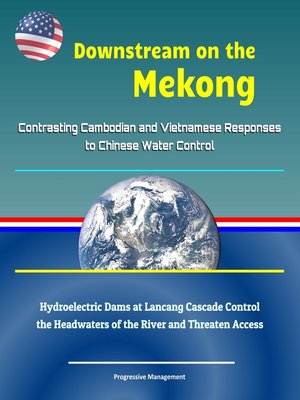Downstream on the Mekong
ebook ∣ Contrasting Cambodian and Vietnamese Responses to Chinese Water Control--Hydroelectric Dams at Lancang Cascade Control the Headwaters of the River and Threaten Access

Sign up to save your library
With an OverDrive account, you can save your favorite libraries for at-a-glance information about availability. Find out more about OverDrive accounts.
Find this title in Libby, the library reading app by OverDrive.



Search for a digital library with this title
Title found at these libraries:
| Library Name | Distance |
|---|---|
| Loading... |
This report has been professionally converted for accurate flowing-text e-book format reproduction. Decreasing supplies of fresh water, growth of the global population, and the transnational nature of much of the world's water resources have made global competition over water increasingly common. In Southeast Asia, Chinese hydroelectric dams at the Lancang Cascade have enabled China to control the headwaters of the Mekong River and threaten downstream states' access to this vital resource. Cambodia and Vietnam are two Southeast Asian states whose economic prosperity is inextricably linked to undisturbed access to the Mekong. Despite similar requirements for river usage, the two states have responded to Chinese control in surprisingly different ways.
This study investigates the different Vietnamese and Cambodian responses to China's Mekong River development by analyzing their requirements for the Mekong River and contrasting each state's relationship with China. The study finds that Cambodia has developed a strategy of appeasement toward China, placing its short-term interests in Chinese economic assistance ahead of its long-term requirements for riparian productivity, while Vietnam has balanced against the super power, demonstrating the resolve to protect its riparian interests. Similarly, the two states both use institutions to offset the super power's significant size and power advantages, providing them an alternative path to shape China's actions.
I. INTRODUCTION * A. MAJOR RESEARCH QUESTION AND FINDINGS * B. SIGNIFICANCE OF THE RESEARCH QUESTION * C. LITERATURE REVIEW * 1. Global Water Politics and Regional Water Requirements * 2. China's Bilateral Relations with Cambodia and Vietnam * D. POTENTIAL EXPLANATIONS AND HYPOTHESES * E. RESEARCH DESIGN * F. THESIS OVERVIEW AND CHAPTER OUTLINE * II. DOMESTIC DRIVERS OF CHINESE ACTIVITIES ON THE MEKONG * A. ENERGY DIVERSIFICATION * B. DEVELOPMENT OF WESTERN PROVINCES * C. POLLUTION REDUCTION * D. INCREASE TRADE WITH DOWNSTREAM NEIGHBORS * E. CONCLUSION * III. CAMBODIAN RESPONSE TO CHINESE HYDROPOWER DEVELOPMENT ON THE MEKONG * A. CAMBODIA'S RIVER NEEDS * B. CHINESE INTERESTS IN CAMBODIA * C. RELATIONSHIP BENEFITS FOR CAMBODIA * D. CAMBODIA'S RESPONSE STRATEGY * E. CONCLUSION * IV. VIETNAMESE RESPONSE TO CHINESE HYDROPOWER DEVELOPMENT ON THE MEKONG * A. VIETNAM'S RIVER NEEDS * B. VIETNAM'S RESPONSE TO CHINESE CONTROL OF THE MEKONG * C. ANALYSIS OF THE RELATIONSHIP * D. VIETNAM'S RESPONSE STRATEGY * E. CONCLUSION * V. CONCLUSION * A. EVALUATING THE NEOREALIST HYPOTHESIS * B. EVALUATING THE NEOLIBERAL HYPOTHESIS * C. IMPLICATIONS * D. RECOMMENDATIONS FOR FURTHER RESEARCH







